1967 United State Grand Prix race report: Lotus lights up the Glen
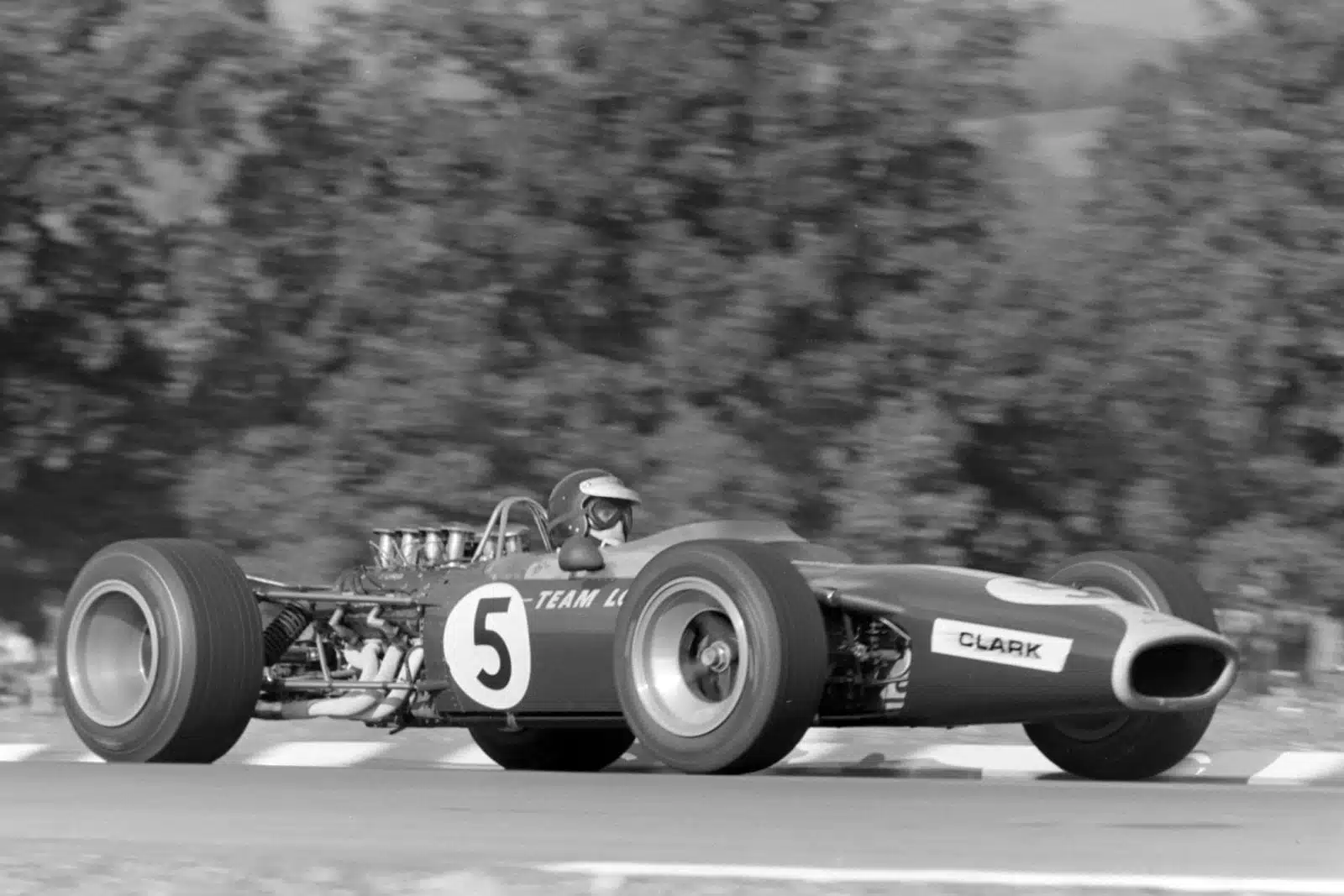
Jim Clark won his third win of he season
Motorsport Images
For the seventh time the Grand Prix of the United States was run on the 3.7-kilometre Watkins Glen circuit. With no starting money but a prize money pool of over 100,000 dollars, paying 20,000 dollars first place and 2,803 dollars last place, all expenses for the round trip from Europe being paid by the organisers, this year’s race had a first-class field.
The Brabham Racing Organisation had their usual cars for Brabham and Hulme, nothing more than race preparation having been done since they left Italy. John Surtees had the Honda with which he won in Italy. Both front cantilever wishbones were much stronger after the buckling which happened in practice at Monza. The engine had been back to Japan to see if the injection unit could be sorted out to give better carburation on pick-up out of corners.
Coopers had the two 1967 cars for Rindt and Ickx. The older of the two cars was fitted with a 36-valve Maserati engine, while the other car had the 36-valve engine but now fitted with 36 plugs. On the normal 24-plug engine the plugs are in pairs on the outside of the vee and on the 36-plug engine an extra plug for each cylinder is on the inside of the vee. The extra distributor is on the enlarged metering unit plate at the back of the engine and is driven from the camshaft by the same toothed belt that drives the metering unit. The explanation for the extra plug is that the pistons were only firing on one side. A successful engine designer who was looking at the engine commented that if you need more than one plug per cylinder there is something very wrong with the design. The fuel pumps on both cars have been moved into the airstream on the front of the engine and are driven by the same, belt that drives, the front right distributor.
Team Lotus had their three Lotus-Cosworths for Clark, Hill and the Mexican driver, M Solana. Except for bringing Clark’s car’s suspension mounting points back into line with the other two cars, nothing had been done to the chassis. On the engine side all three had been damaged at Monza and they were all rebuilt. There were the H16 BRMs for Stewart, Spence and Irwin.
The last named, although being worked on and run with the two works cars, was officially entered by Parnell Racing. For Stewart there was the lighter 1151 car, while the other two were 8302 and 8303, all using normal I-H6 engines.
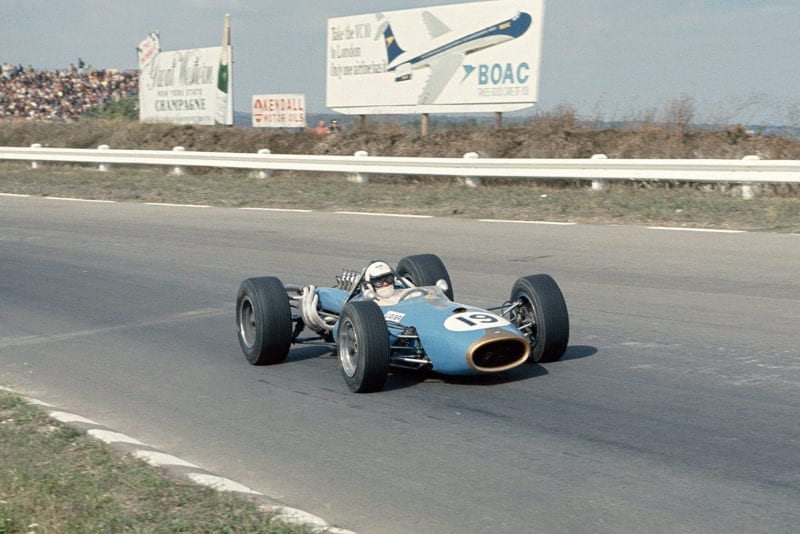
Ligier was entered in an ex-Hulme Brabham
Motorsport Images
Ferrari brought two cars for Amon, both with the latest 48-valve engines and the latest chassis, 0007, was numbered as the race car, with an old chassis, 003, for the spare. This 003 chassis was fitted with 0005 number for carnet purposes and was used as the training car.
The Anglo-American Racers team were originally to enter two cars but after the damage to both engines in the opening laps at Monza it was decided to enter only Gurney in the lighter 104 chassis. The only major difference on the Eagle was a new ZE-type differential.
McLaren had his McLaren-BRM V12, the engine all welded up and rebuilt, and the McLaren team were very confident the car would go well. The whole team were very happy and buoyant, no doubt the three Can-Am victories and the large prize money connected with this making some small contribution to the team atmosphere.
Siffert was driving the Walker-Durlacher Copper-Maserati, while Bonnier had his own Cooper-Maserati. Ligier was driving his ex-Hulme Brabham-Repco, while the final car was for Beltoise, a Matra-Cosworth EVA Formula Two. This car was weighted with lead and had extra large fuel tanks, and was invited to get the American public used to a new name which should be here next year with a Formula One car.
Qualifying
Practice was on Friday and Saturday afternoons for four hours each day. The times from the previous year, which were the target for this year, were Surtees fastest race lap of 1min 9.67sec (191.270kph) and Brabham’s practice lap of 1min 8.42sec (194-843kph).
At this time of the year in upper New York State the weather can be warm summer or distinctly winter, and this year practice started under the winter heading. A front stationary over the whole area closed airports with low cloud, mist and rain. This caused some of the last-minute arrivals from Europe to get stranded in New York City for the night and make long, roundabout journeys to the Glen.
“The weather was still bad…low cloud swirled over and poured off the hill on which the circuit is situated and into the valley and over Lake Seneca”
At 2pm as practice started the weather was still bad and visibility ranged from a quarter of a mile to 20 yards as the low cloud swirled over and poured off the hill on which the circuit is situated and into the valley and over Lake Seneca.
McLaren and Amon were the first out and they felt their way round very slowly. Ligier, Bonnier, Siffert, Clark and Surtees all went out in the first hour and for some time Bonnier was quickest as he roared through the swirling mist, but Surtees completed the first hour with a time of 1min 22sec.
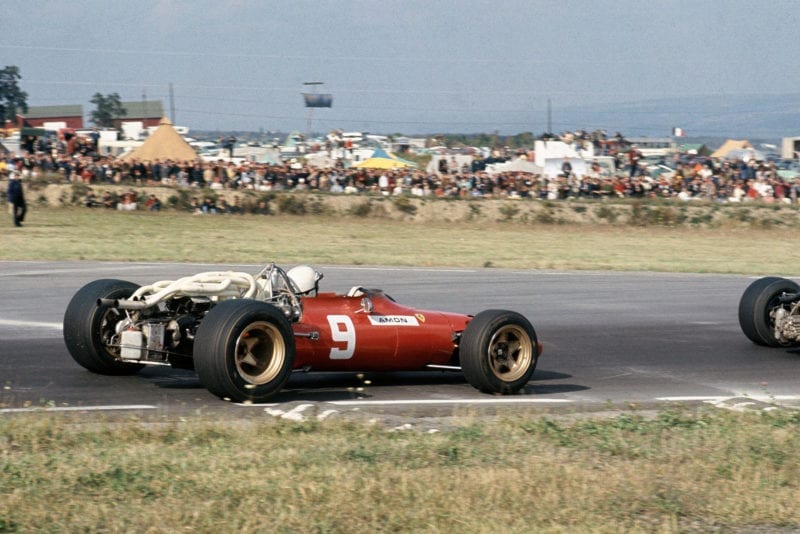
Not for the first time this season, Amon was the only Ferrari entry
Motorsport Images
During the second hour the rain stopped but the mist persisted and both Brabhams and the Gurney Stayed well away. Ickx came out with the older Cooper, while the other with the 36-plug engine was found to have a had water leak at the front of the engine just behind the bulkhead. This entailed half removing the engine to get at the leak and kept the car away from practice.
BRMs also kept away while the weather was at its worst and came out as conditions improved during the third hour. Brabham appeared as conditions improved but on his first lap a valve broke and damaged the engine, so the car was wheeled away to have the spare, an “old banger”, fitted until the engine in transit from London arrived in the early hours of race day.
“Hill was the only driver to get down into the 1min 7sec bracket, proving once again the performance of the Lotus-Cosworth”
Rindt, unable to drive his own car, put his number on Ickx’s car and did a few laps’ practice, getting down to just under 1min 10sec before a rod broke, giving the Cooper mechanics another 22-hour engine change.
Clark was trying both his own car and the one Solana was to use. In the latter he first got under 1min 10sec as it felt better on the drying track than his own car. However, before the day was finished Clark was the only driver to get down into the 1min 6sec bracket and Hill was the only driver to get down into the 1min 7sec bracket, proving once again the performance of the Lotus-Cosworth.
Siffert stopped with suspected transmission troubles but these proved to be only an unbalanced wheel. Solana didn’t get a drive on the first day, as is becoming the custom for the third Lotus driver. The Honda, which finished up with a time of 1min 8.65sec, was misfiring badly and came on to 12 cylinders only for short bursts. When the Japanese mechanics got the car back to the technical centre they stripped the complicated fuel injection system, cleaned it and rerouted some of the pipes.
Saturday was fine with a few threatening clouds which never materialised. All except Lotus and Matra were out when practice started at mid-day. BRM had some ultra wide wheels to take a Goodyear GT tyre with little tread on the 12in of width that came in contact with the road.
These particular tyres arc being used on the winning McLarens in the Group 7 racing and have 2”, spacers in the mould to get the extra width. This causes two small shoulders round the centre of the tyre which need scrubbing off before the best adhesion is obtained. After several laps Stewart changed the fronts back to conventional tyres, then he changed the rears, and decided he preferred the handling of the normal tyres.
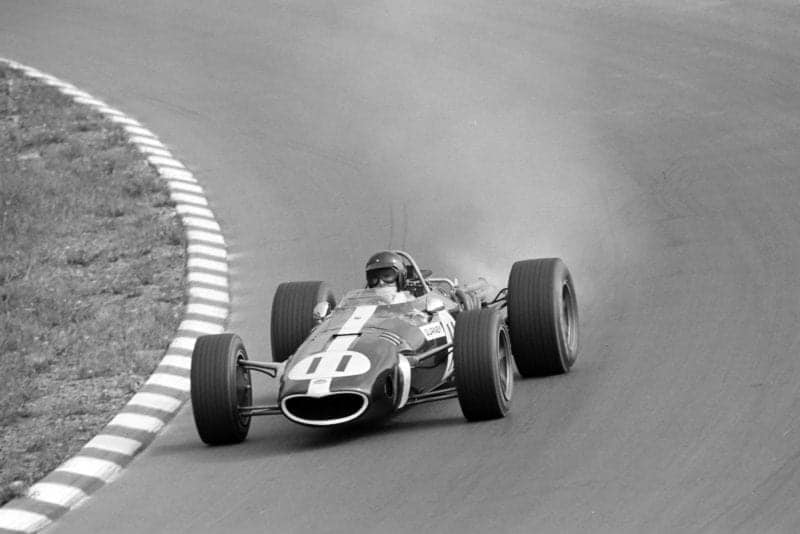
Gurney experienced engine issues throughout qualifying
Motorsport Images
Rindt had out the 36-plug Cooper but was not very happy as the brakes were playing up and he did not like this at all, so after Some time bleeding and adjusting he handed the new car over to Ickx and went out in the older car, which he threw around with his usual verve.
Gurney was not very happy with his engine and when he was on the hack straight the whole of the engine tightened up when the scavenge pump broke. McLaren was not having a very happy day as the new limited slip differential was playing up. On one part of the circuit there are a series of bumps which make the rear wheels lift and as they do the differential momentarily freewheels, which, with the engine near peak revs; could be disastrous.
After spending a lot of time in the garage McLaren rushed out in the last few minutes of practice and was unable to lift off quickly enough to get the revs down when it bounced without being cured. Although nothing came through the side of the engine, 12,000+ revs did not do it any good.
Clark led the burst of speed in the last half of practice by going out and getting a time of 1min 06.07sec, the first lap at over 125mph and one full second faster than his nearest rival.
Then with tanks full he put in a time for himself of 1min 6.9sec. Solana was allowed out in the third Lotus now that Clark would not need it, and to everyone’s surprise, including his own, he got down to 1min 7.88sec, seventh fastest overall in only nine laps of practice, which either says a lot for his improvement since last year or that the Lotus is an easier car to drive than it looks.
Brabham, Amon and Gurney; before his engine broke, all got under 1min 7sec. Then Hill went out for his final few laps and thoroughly shook everyone by getting down to Clark’s time, then getting a bit faster and finally clipping a half-second off the best time to give himself pole position and the 1,000 dollar prize with a time of 1min 05.48sec (203.501kph).
This concluded practice and four teams were working hard at their engines: Gurney and McLaren to see what damage had been done; Brabham removing the old engine and hoping the other would arrive in time; Surtees had a metering Unit break in the last run and this could have been the trouble all along, so the mechanics were to attempt to take off the metering unit from the spare engine and lit it.
While this work was getting under way the largest crowd of campers ever to congregate at Watkins Glen started to barbecue their evening meals and the police were forced to close the gates as there was no more room to pitch tents.
Race

Graham Hill leads from Dan Gurney at the start
Motorsport Images
Race morning was fine and a huge crowd and long traffic jams began to develop. The Brabham engine had arrived and was fitted. Gurney had replaced the scavenge pump, Honda had managed to fit the injection unit from one engine to the other, and McLaren found the engine to be runnable but changed the differential unit.
These four cars went out and used a portion of the track to see how the engines were running. After the usual preliminaries the cars all did a warming-up lap and then they assembled on the dun-any grid for the 108 lap race.
“Hill was firmly in first place but Gurney had got by Clark and was going very well”
At 2pm precisely the flag dropped and the Lotuses of Hill and Clark shot into the lead. As they completed the first lap Hill led from Clark and Gurney. Then, still very close, Brabham, Anion, Hulme, McLaren, Stewart, Silica, Rindt, Surtees, Solana, Spence, Irwin, Ickx, Bonnier, with Ligier and Beltoise bringing up the rear. On the next lap Hill was firmly in first place but Gurney had got by Clark and was going very well.
On the second lap it was a repeat of the first, except that Surtees passed Rindt to gain one place. Lap 3 brought the first pit stop when Ickx pulled in with steam pouring from the breather, but after losing almost a lap the young Belgian was on his way. Solana completed his third lap and then vanished for some 40 laps.
The Lotus-Cosworth had stopped on the circuit with a dead engine. Two mechanics went out to the car and prodded at the electrics until it suddenly burst into life. When Solana reappeared on the lap chart the race was almost half run and Chapman pulled him in as he would have been disqualified for receiving attention outside the pit area.
The leaders were pressing on at a hot pace. Gurney got by Clark on lap 2 and began to push Hill. Anton was fifth once more, just behind Brabham. Hulme challenged the Ferrari and was soon by into fifth place; then next lap be was ahead of Brabham. It took Hulme three laps to establish his lead over Brabham and not before losing the place for one more lap.
Then Amon got into his stride and found that with his extra horse-power he could get by up the hill. So, on the 10th lap Amon passed Brabham and fixed his ‘sights on Hulme. Gurney’s second place did not last long for on the eighth lap Clark got by and then the two Lotus 495 were running in close company, with the rest hanging on. Surtees, whose 11th place on the grid was due to poor carburation, found things running much better.
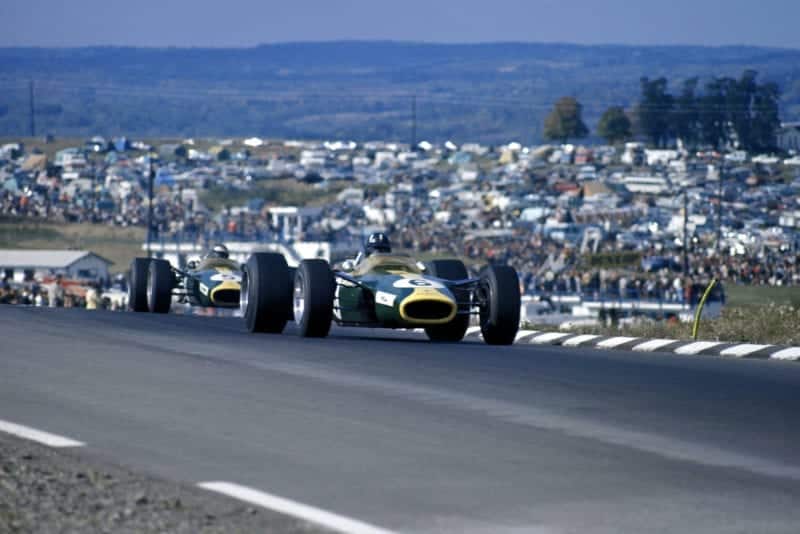
Hill and Clark ran in close company upfront, with the rest hanging on
Motorsport Images
He moved forward lap by lap until by the 10th lap he was right on Brabham’s tail. On the next lap he was past into sixth place, which he held for only two laps before the engine started to cause trouble. A 45sec pit stop made no difference and two laps later he again stopped at the pits, where it was discovered that a non-return valve was not working as it bad a piece of rubber stuck under the valve. The rubber had obviously broken away from the inside of the fuel bags, and when removed Surtees re-joined some laps down and started charging through the field.
McLaren’s was one of the cars passed by Surtees and it was obvious that the BRM was not in full tune, but he was not going to lose much. Unfortunately McLaren slid on oil just by the pits and ran over a low curb. The curb was not low enough, however, and caught the water pipe which runs under the length of the car, and McLaren subsequently lost four places.
Three laps later, with no water left, McLaren retired, leaving 16 cars. Amon went on pushing Hulme until on lap 16 he was up into fourth place behind Gurney. Gurney now seemed to be having difficulties for he was unable to stop Amon passing him on the 21st lap, and after completing 24 laps he came into the pits where it was found that the pin which holds the lower wishbone to the upright had broken and this had been causing bad bump steering.
Hulme had lost 500revs and for many laps he had difficulty trying to hold his lap times. The situation at 1-8 laps had been: Hill and Clark nose to tail, then a 1-sec gap to Gurney and Amon, 4.5sec behind the leader came Hulme who was 2sec ahead of Brabham.
Then there came a big gap of 20sec to a trio of Siffert, Stewart and Rindt, with Spence five more seconds down and Irwin and Bonnier about to be lapped. All the rest were more than a lap down.
Stewart’s BRM was beginning to lose its brakes and for some time it had been smoking badly. On the 25th lap he came into the pits with grass and small bushes up the radiator inlet and stuck in the suspension, results of running off at the end of the straight and almost reaching the trees.
After a quick clean-out and a look at the brakes Stewart was out again, one from last. Amon had now closed on the two Lotus-Cosworths and the trio were running in a tight bunch until they lapped Bonnier, who, after the two Lotuses had passed, chopped back, very nearly putting Amon on the grass. This let the Lotuses open up a 4sec gap which the Ferrari driver was never able to get back.

On lap 25 Stewart had an off due to break trouble
Motorsport Images
Ickx was still plodding on in last place, blowing steam most of the time, and after a lot of pit stops he finally retired with burnt pistons. Earlier Rindt had gone out with the same trouble. Spence had his BRM up to eighth place at one time but it was never over-quick and when Rindt retired from seventh place, Spence stepped into this place.
Then two laps later a rod broke in the H16 engine and he too retired. Next to retire, with identical trouble, was Irwin in another H16 BRM. He cut his engine and coasted on to the grass when he heard a very expensive noise from the back. Ligier, who had been in the tail of the field from the start, retired on lap 44 with a broken camshaft.
Things began to settle down now. Clark passed Hill as the clutch began to play up on the then leading Lotus; Amon, who was still trying desperately to catch the Lotuses, was being baulked by Surtees who was four laps down but was once again going well and had passed Amon.
Some laps later, the Honda’s engine began to miss when the same exhaust pipe fractured, overheating the metering unit, and Amon was away again on his own. At last he began to make an impression on Hill who was dropping back from Clark. On lap 65 Amon came round the corner by the pits and found Hill trying to get into gear, and as the Ferrari swept by the Lotus driver found a cog and went off in pursuit.
In fifth place Brabham was losing ground and having cornering difficulties, so eventually he came into the pit to see what was wrong. The left rear tyre had a slow puncture and when this was changed the front left was also changed as this was badly worn due to having the extra load thrown on to it.
As Brabham regained the field so Stewart retired with a broken metering belt after having again almost reached the woods at the end of the long straight. Bonnier made a pit stop when he found the Cooper-Maserati handling badly, and it was found that the wheel centre was breaking up. As this was changed Beltoise went by, so when Bonnier rejoined the race he was in last position. Hill managed to get the hang of his trouble and caught and passed Amon -who, unbeknown to his team, was watching the oil pressure needle getting lower and lower each lap.
On lap 84 Hill again got stuck out of gear and the Ferrari again went by while Hill was struggling to get it engaged. This time he was so far behind it looked as if he would have to be Satisfied with third place. Surtees made two pit stops to have water poured over the metering unit to cool this off.
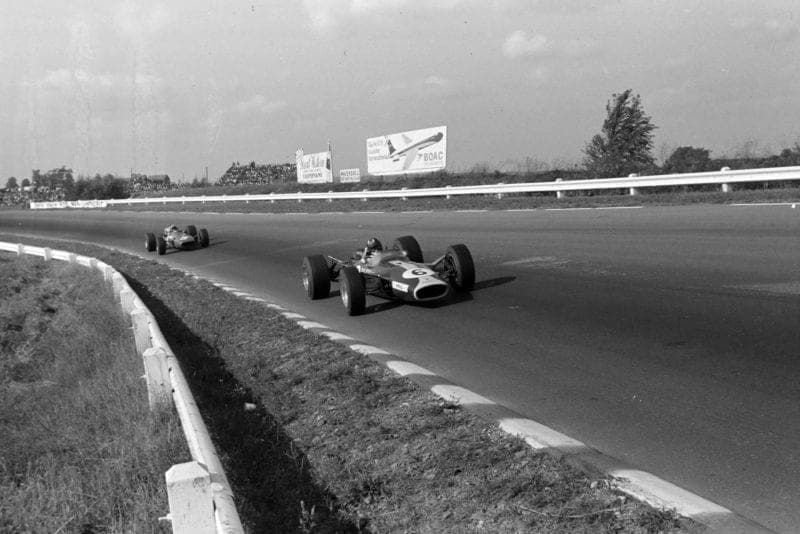
With both cars ailing, Hill and Amon became locked in a duel of wits and reliability
Motorsport Images
On the second occasion there was not enough power in the battery to re-start as the alternator had not been functioning properly. This looked like the last incident in a fairly exciting race but it was not. Amon, 24sec behind Clark, suddenly went missing. Two cars going by the pits gave Ferrari thumbs-up signs but it was only after the race that they knew Amon had blown up the engine through lack of oil just 12 laps from the end.
Now it was one healthy Lotus 49 followed by one sick Lotus 49 in first and second places. The last laps ticked by, then halfway round the 106th lap, the top link of the right-hand rear suspension of Clark’s car broke at the inner weld (see Pictorial Review) and the wheel fell in at an extreme angle.
“When the pits and the crowd saw what was wrong it became obvious that the first position was vulnerable”
Fortunately, the next corner was a right-hander and going round it Clark looked back to examine the damage. By driving slowly round left-handers, he reached the pits where Chapman and his team were anxiously looking at their watches. When the pits and the crowd saw what was wrong it became obvious that the first position was vulnerable.
Hill’s sick Lotus was 45sec behind when Clark began those last two slow laps. He almost halved the gap in one lap and when Clark reached the chequered flag the two Lotuses were only 6sec apart. So, Lotus got their “one-two” win which would have gone to Amon if he had kept going for he would have had only 24sec to make up. Hulme was second one lap down, with Siffert fourth two laps down. Then four laps behind the winner was Brabham and the only other two running were Bonnier and Beftoise running in that order (Bonnier passed the Frenchman two laps from the end) seven laps down.
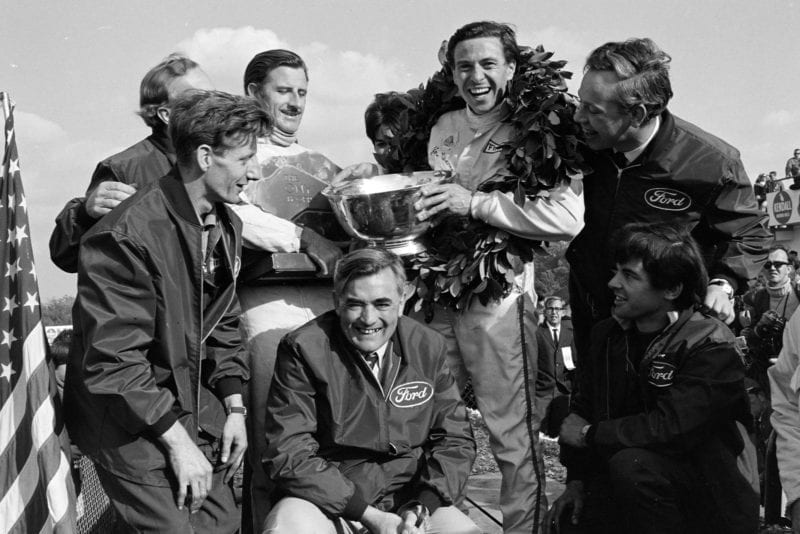
The Lotus team celebrate on the podium
Motorsport Images
The huge crowd burst over the fences before the cars were in the pits, as in fact certain spectators had dodged the “law” to get to the edge of the track to photograph during the race. This danger to ordinary members of the public is very real when they don’t realise the dangers, and it is hoped that some of the considerable profits made at the meeting will go back in the form of fences and banks.
“The huge crowd burst over the fences before the cars were in the pits, as in fact certain spectators had dodged the “law” to get to the edge of the track to photograph during the race”
The United States Grand Prix was as well run as ever and it could be said that Chapman and Duckworth had designed their cars to win a 108-lap race for they certainly wouldn’t have won if the race had been 120 laps. Luck or brilliant designing?
